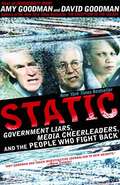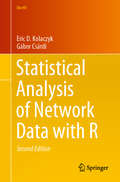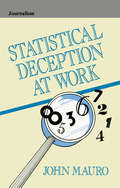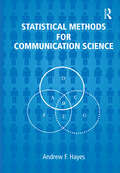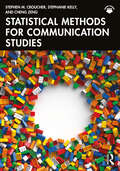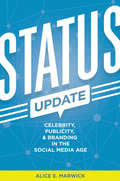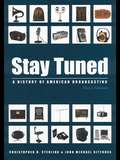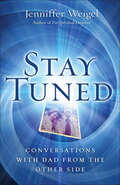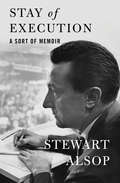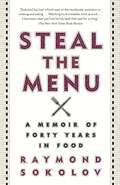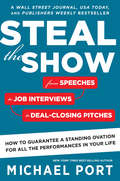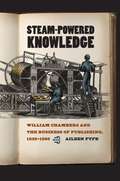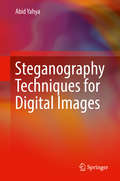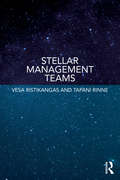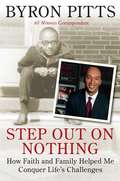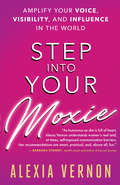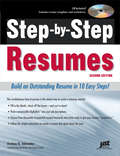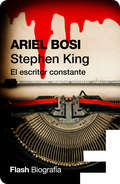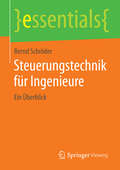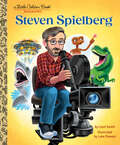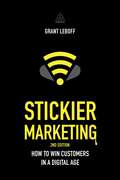- Table View
- List View
Static: Government Liars, Media Cheerleaders, and the People Who Fight Back
by Amy GoodmanTorture. Kidnapping. Bogus wars. Illegal wiretapping. Propaganda. Spies in the newsrooms. Oil profiteers. Soldiers who won't fight. Mothers of fallen soldiers Who will.In Static, the bestselling brother-sister team of Amy Goodman, host of Democracy Now!, and investigative journalist David Goodman takes on government liars, corporate profiteers, and the media that have acted as their cheerleaders. The authors cut through the official static to show the truth about war, torture, and government control of the media. Static breaks the sound barrier to present the voices of dissidents, activists, and others who are often frozen out of official debate.Read Static. Become informed. Fight back. Defend democracy.
Statistical Analysis of Network Data with R (Use R! #65)
by Eric D. Kolaczyk Gábor CsárdiThe new edition of this book provides an easily accessible introduction to the statistical analysis of network data using R. It has been fully revised and can be used as a stand-alone resource in which multiple R packages are used to illustrate how to conduct a wide range of network analyses, from basic manipulation and visualization, to summary and characterization, to modeling of network data. The central package is igraph, which provides extensive capabilities for studying network graphs in R. The new edition of this book includes an overhaul to recent changes in igraph. The material in this book is organized to flow from descriptive statistical methods to topics centered on modeling and inference with networks, with the latter separated into two sub-areas, corresponding first to the modeling and inference of networks themselves, and then, to processes on networks. The book begins by covering tools for the manipulation of network data. Next, it addresses visualization and characterization of networks. The book then examines mathematical and statistical network modeling. This is followed by a special case of network modeling wherein the network topology must be inferred. Network processes, both static and dynamic are addressed in the subsequent chapters. The book concludes by featuring chapters on network flows, dynamic networks, and networked experiments. Statistical Analysis of Network Data with R, 2nd Ed. has been written at a level aimed at graduate students and researchers in quantitative disciplines engaged in the statistical analysis of network data, although advanced undergraduates already comfortable with R should find the book fairly accessible as well.
Statistical Deception at Work (Routledge Communication Series)
by John MauroWritten to reveal statistical deceptions often thrust upon unsuspecting journalists, this book views the use of numbers from a public perspective. Illustrating how the statistical naivete of journalists often nourishes quantitative misinformation, the author's intent is to make journalists more critical appraisers of numerical data so that in reporting them they do not deceive the public. The book frequently uses actual reported examples of misused statistical data reported by mass media and describes how journalists can avoid being taken in by them. Because reports of survey findings seldom give sufficient detail of methods on the actual questions asked, this book elaborates on questions reporters should ask about methodology and how to detect biased questions before reporting the findings to the public. As such, it may be looked upon as an "elements of style" for reporting statistics.
Statistical Methods for Communication Science (Routledge Communication Series)
by Andrew F. HayesStatistical Methods for Communication Science is the only statistical methods volume currently available that focuses exclusively on statistics in communication research. Writing in a straightforward, personal style, author Andrew F. Hayes offers this accessible and thorough introduction to statistical methods, starting with the fundamentals of measurement and moving on to discuss such key topics as sampling procedures, probability, reliability, hypothesis testing, simple correlation and regression, and analyses of variance and covariance. Hayes takes readers through each topic with clear explanations and illustrations. He provides a multitude of examples, all set in the context of communication research, thus engaging readers directly and helping them to see the relevance and importance of statistics to the field of communication.Highlights of this text include:*thorough and balanced coverage of topics;*integration of classical methods with modern "resampling" approaches to inference;*consideration of practical, "real world" issues;*numerous examples and applications, all drawn from communication research;*up-to-date information, with examples justifying use of various techniques; and*a CD with macros, data sets, figures, and additional materials.This unique book can be used as a stand-alone classroom text, a supplement to traditional research methods texts, or a useful reference manual. It will be invaluable to students, faculty, researchers, and practitioners in communication, and it will serve to advance the understanding and use of statistical methods throughout the discipline.
Statistical Methods for Communication Studies
by Stephen M. Croucher Cheng Zeng Stephanie KellyA step-by-step guide through various stages of data preparation and analysis, this text demonstrates descriptive and inferential statistics in communication studies.This book equips communication students with the tools they need to engage in quantitative research, ensuring that they understand why the statistical tools they chose are most appropriate for their data. Using examples and data directly relevant to communication researchers, this text provides guidance on how to use and interpret SPSS and write up results, with further guidance via free online material in using Excel and R. Instead of focusing on formulas and in-depth mathematics, this book provides a hands-on approach to understanding the theory, practice, and application of statistical methods in communication. In addition to covering the standard statistical tools used to analyze social science data for hypothesis testing (e.g., correlation, regression, ANOVA), it also covers advanced factor-analytic techniques specific to measurement validation as well as data visualization guidance.Ideally suited for statistics or quantitative methods courses in communication studies programs at the advanced and graduate level.Online resources include tutorials on SPSS, Excel, and R for key constructs and practice quizzes for students. Instructors will find an instructor manual and test bank. Please visit www.routledge.com/9781032814872.
Statistical Robust Beamforming for Broadcast Channels and Applications in Satellite Communication (Foundations in Signal Processing, Communications and Networking #22)
by Andreas GründingerThis book investigates adaptive physical-layer beamforming and resource allocation that ensure reliable data transmission in the multi-antenna broadcast channel. The book provides an overview of robust optimization techniques and modelling approximations to deal with stochastic performance metrics. One key contribution of the book is a closed-form description of the achievable rates with unlimited transmit power for a rank-one channel error model. Additionally, the book provides a concise duality framework to transform mean square error (MSE) based beamformer designs, e.g., quality of service and balancing optimizations, into equivalent uplink filter designs. For the algorithmic solution, the book analyses the following paradigm: transmission to receivers with large MSE targets (low demands) is switched off if the transmit power is low. The book also studies chance constrained optimizations for limiting the outage probability. In this context, the book provides two novel conservative outage probability approximations, that result in convex beamformer optimizations. To compensate for the remaining inaccuracy, the book introduces a post-processing power allocation. Finally, the book applies the introduced beamformer designs for SatCom, where interference from neighboring spotbeams and channel fading are the main limitations.
Status Update
by Alice E. MarwickSocial media technologies such as YouTube, Twitter, and Facebook promised a new participatory online culture. Yet, technology insider Alice Marwick contends in this insightful book, "Web 2.0" only encouraged a preoccupation with status and attention. Her original research--which includes conversations with entrepreneurs, Internet celebrities, and Silicon Valley journalists--explores the culture and ideology of San Francisco's tech community in the period between the dot com boom and the App store, when the city was the world's center of social media development. Marwick argues that early revolutionary goals have failed to materialize: while many continue to view social media as democratic, these technologies instead turn users into marketers and self-promoters, and leave technology companies poised to violate privacy and to prioritize profits over participation. Marwick analyzes status-building techniques--such as self-branding, micro-celebrity, and life-streaming--to show that Web 2.0 did not provide a cultural revolution, but only furthered inequality and reinforced traditional social stratification, demarcated by race, class, and gender.
Stay Tuned: A History of American Broadcasting (Routledge Communication Series)
by Christopher H. Sterling John Michael KittrossSince its initial publication in 1978, Stay Tuned has been recognized as the most comprehensive and useful single-volume history of American broadcasting and electronic media available. This third edition has been thoroughly revised and updated to bring the story of American broadcasting forward to the 21st century, affording readers not only the history of the most important and pervasive institution affecting our society, but also providing a contextual transition to the Internet and other modern media. The enthusiasm of authors Christopher H. Sterling and John Michael Kittross is apparent as they lead readers through the development of American electronic mass media, from the first electrical communication (telegraph and telephone); through radio and television; to the present convergence of media, business entities, programming, and delivery systems, including the Internet. Their presentation is engaging, as well as informative, promoting an interest in history and making the connections between the developments of yesterday and the industry of today. Features of this third edition include: *chronological and topical tables of contents; *new material reflecting modern research in the field; *a new chapter describing historical developments from 1988 through to the current day; *an expanded bibliography, including Web site and museum listings; *an updated and expanded glossary and chronology; and *extensive statistical data of the development of television and radio stations, networks, advertising, programming, audiences, and other aspects of broadcasting. Designed for use in undergraduate and graduate courses on the history of American mass media, broadcasting, and electronic media, Stay Tuned also fits well into mass communication survey courses as an introduction to electronic media topics. As a chronicle of American broadcasting, this volume is also engaging reading for anyone interested in old radio, early television, and the origins and development of American broadcasting.
Stay Tuned: Conversations with Dad from the Other Side
by Jenniffer WeigelThis Emmy Award–winning broadcaster’s memoir “takes you on a fun ride. Enjoy the journey to self-awareness and have a good laugh along the way” (James Van Praagh, author of Talking to Heaven).Television journalist Jenniffer Weigel takes readers on a humorous, yet deeply moving journey as she struggles to find her own spiritual path during the illness and death of her father, popular sportscaster Tim Weigel. During his illness, while Tim turns to alternative treatments like chi gong and reiki sessions, Jenniffer reads Neale Donald Walsch, starts a spiritual diet plan, and uses the law of attraction to find free parking spaces. After his death, she does everything she can to have one more conversation with her dad from the “other side.” Stay Tuned is a witty, irreverent trip through popular spiritual beliefs and the insights of masters and celebrities, including conversations with don Miguel Ruiz, James Van Praagh, Caroline Myss, Deepak Chopra, and Russell Crowe. This is the funny, heart-breaking, and touching story of one skeptical journalist’s transformation from “cynical daughter” to “spiritual woman.”
Stay of Execution: A Sort of Memoir
by Stewart AlsopA poignant memoir of a full life and an impending death, written by one of America&’s foremost journalists during his battle with terminal cancer. For three decades, from the end of World War II well into the Watergate era, internationally renowned newspaper and magazine columnist Stewart Alsop was a fixture on the Washington, DC, political landscape. In 1971, the respected journalist was diagnosed with a rare form of leukemia, marking the beginning of his courageous three-year battle with the terrible cancer that ravaged his body but could not damage his spirit or slow his facile and brilliantly incisive mind. A passionate social critic and peerless political analyst who hobnobbed with presidents from FDR to Nixon, and enjoyed the respectful fellowship of such notable figures as Winston Churchill, Alice Roosevelt Longworth, and Henry Kissinger, Alsop insightfully chronicles the course of his medical history without a trace of maudlin self-pity while celebrating his family, friends, colleagues, and an extraordinary life well lived. Stay of Execution is Stewart Alsop&’s moving, powerful, and inspiring memoir of his terminal illness and his life before—an unforgettable true story of courage and accomplishment, trials and tragedy from one of the most revered American journalists of the twentieth century.
Steal the Menu: A Memoir of Forty Years in Food
by Raymond SokolovFour decades of memories from a gastronome who witnessed the food revolution from the (well-provisioned) trenches--a delicious tour through contemporary food history. When Raymond Sokolov became food editor of The New York Times in 1971, he began a long, memorable career as restaurant critic, food historian, and author. Here he traces the food scene he reported on in America and abroad, from his pathbreaking dispatches on nouvelle cuisine chefs like Paul Bocuse and Michel Guérard in France to the rise of contemporary American food stars like Thomas Keller and Grant Achatz, and the fruitful collision of science and cooking in the kitchens of El Bulli in Spain, the Fat Duck outside London, and Copenhagen's gnarly Noma. Sokolov invites readers to join him as a privileged observer of the most transformative period in the history of cuisine with this personal narrative of the sensual education of an accidental gourmet. We dine out with him at temples of haute cuisine like New York's Lutèce but also at a pioneering outpost of Sichuan food in a gas station in New Jersey, at a raunchy Texas chili cookoff, and at a backwoods barbecue shack in Alabama, as well as at three-star restaurants from Paris to Las Vegas. Steal the Menu is, above all, an entertaining and engaging account of a tumultuous period of globalizing food ideas and frontier-crossing ingredients that produced the unprecedentedly rich and diverse way of eating we enjoy today.
Steal the Show
by Michael PortAn inspiring program full of essential advice for spotlight lovers and wallflowers alike that will teach readers how to bring any crowd to its feet Every day there are moments when you must persuade, inform, and motivate others effectively. Each of those moments requires you, in some way, to play a role, to heighten the impact of your words, and to manage your emotions and nerves. Every interaction is a performance, whether you're speaking up in a meeting, pitching a client, or walking into a job interview. In Steal the Show, New York Times best-selling author Michael Port draws on his experience as an actor and as a highly successful corporate speaker and trainer to teach readers how to make the most of every presentation and interaction. He demonstrates how the methods of successful actors can help you connect with, inspire, and persuade any audience. His key strategies for commanding an audience's attention include developing a clear focus for every performance, making sure you engage with your listeners, and finding the best role for yourself in order to convey your message with maximum impact. Michael Port is one of the most in-demand corporate speakers working today. His presentations are always powerful, engaging, and inspirational. And yes, audiences always give him a standing ovation.
Stealing Time: Steve Case, Jerry Levin, and the Collapse of AOL
by Alec KleinWhy the concept failed.Why the concept failed.
Steam-Powered Knowledge: William Chambers and the business of publishing, 1820-1860
by Aileen FyfeWith the overwhelming amount of new information that bombards us each day, it is perhaps difficult to imagine a time when the widespread availability of the printed word was a novelty. In early nineteenth-century Britain, print was not novel—Gutenberg’s printing press had been around for nearly four centuries—but printed matter was still a rare and relatively expensive luxury. All this changed, however, as publishers began employing new technologies to astounding effect, mass-producing instructive and educational books and magazines and revolutionizing how knowledge was disseminated to the general public. In Steam-Powered Knowledge, Aileen Fyfe explores the activities of William Chambers and the W. & R. Chambers publishing firm during its formative years, documenting for the first time how new technologies were integrated into existing business systems. Chambers was one of the first publishers to abandon traditional skills associated with hand printing, instead favoring the latest innovations in printing processes and machinery: machine-made paper, stereotyping, and, especially, printing machines driven by steam power. The mid-nineteenth century also witnessed dramatic advances in transportation, and Chambers used proliferating railway networks and steamship routes to speed up communication and distribution. As a result, his high-tech publishing firm became an exemplar of commercial success by 1850 and outlived all of its rivals in the business of cheap instructive print. Fyfe follows Chambers’s journey from small-time bookseller and self-trained hand-press printer to wealthy and successful publisher of popular educational books on both sides of the Atlantic, demonstrating along the way the profound effects of his and his fellow publishers’ willingness, or unwillingness, to incorporate these technological innovations into their businesses.
Steganography Techniques for Digital Images
by Abid YahyaThis book covers newly developed and novel Steganography techniques and algorithms. The book outlines techniques to provide security to a variety of applications using Steganography, with the goal of both hindering an adversary from decoding a hidden message, and also preventing an adversary from suspecting the existence of covert communications. The book looks into applying these newly designed and improved algorithms to provide a new and efficient Steganographic system, called Characteristic Region-Based Image Steganography (CR-BIS). The algorithms combine both the robustness of the Speeded-Up Robust Features technique (SURF) and Discrete Wavelet Transform (DWT) to achieve characteristic region Steganography synchronization. The book also touches on how to avoid hiding data in the whole image by dynamically selecting characteristic regions for the process of embedding. Applies and discusses innovative techniques for hiding text in a digital image file or even using it as a key to the encryption;Provides a variety of methods to achieve characteristic region Steganography synchronization;Shows how Steganography improves upon cryptography by using obscurity features.
Steganography in Digital Media
by Jessica FridrichSteganography, the art of hiding of information in apparently innocuous objects or images, is a field with a rich heritage, and an area of rapid current development. This clear, self-contained guide shows you how to understand the building blocks of covert communication in digital media files and how to apply the techniques in practice, including those of steganalysis, the detection of steganography. Assuming only a basic knowledge in calculus and statistics, the book blends the various strands of steganography, including information theory, coding, signal estimation and detection, and statistical signal processing. Experiments on real media files demonstrate the performance of the techniques in real life, and most techniques are supplied with pseudo-code, making it easy to implement the algorithms. The book is ideal for students taking courses on steganography and information hiding, and is also a useful reference for engineers and practitioners working in media security and information assurance.
Stellar Management Teams
by Vesa Ristikangas Tapani RinneManagement teams at all levels, and individual team members in particular, are often disengaged and disconnected from the management function itself. Statements such as, "we lack common goals or they are unclear", "I have no influence", "I am not listened to nor taken into account", and "I do not feel valued – actually, nobody does", are commonplace. The authors argue this is because we have been entrenched in an era of guru leadership but that it must come to an end if our management teams are to rise to the top. An individual is not capable of controlling the complicated system of an organization, with its countless variables, especially in conjunction with the rapid change in both the economy and market forces, which are unpredictable and uncontrollable. No matter how talented the individual, no one person is in a position to manage this complex system alone – not even a guru leader. The authors contend that what is needed now are resilient trendsetters who will bring about a new era of top-performing teams that together form a "collective guru", which they refer to as a Stellar Management Team. In this book, the reader undertakes a metaphorical journey to the stars, which symbolizes top-level interaction and collaboration. The journey is the development from an ordinary management team into a Stellar Management Team, which elevates its operation up to a new level of performance and success.
Step Out on Nothing: How Faith and Family Helped Me Conquer Life's Challenges
by Byron PittsIt was August 25, 2006, my first on-camera studio open for the CBS News broadcast 60 Minutes. Executive Producer Jeff Fager poked his head in the dressing room. "Good luck, Brotha! You've come a long way to get here. You've earned it." If only he knew. My mind flashed back to elementary school, when a therapist had informed my mother, "I'm sorry, Mrs. Pitts, your son cannot read. " In Step Out on Nothing, Byron Pitts chronicles his astonishing story of overcoming a childhood filled with obstacles to achieve enormous success in life. Throughout Byron's difficult youth - his parents separated when he was twelve and his mother worked two jobs to make ends meet - he suffered from a debilitating stutter. But Byron was keeping an even more embarrassing secret: He was also functionally illiterate. For a kid from inner-city Baltimore, it was a recipe for failure. Pitts turned struggle into strength and overcame both of his impediments. Along the way, a few key people "stepped out on nothing" to make a difference for him - from his mother, who worked tirelessly to raise her kids right and delivered ample amounts of tough love, to his college roommate, who helped Byron practice his vocabulary and speech. Pitts even learns from those who didn't believe in him, like the college professor who labeled him a failure and told him to drop out of college. Through it all, he persevered, following his steadfast passion. After fifteen years in local television, he landed a job as a correspondent for CBS News in 1998, and went on to become an Emmy Award - winning journalist and a contributing correspondent for 60 Minutes. Not bad for a kid who couldn't read. From a challenged youth to a reporting career that has covered 9/11 and Iraq, Pitts's triumphant and uplifting story will resonate with anyone who has felt like giving up in the face of seemingly insurmountable hardships.
Step Out on Nothing: How Faith and Family Helped Me Conquer Life's Challenges
by Byron PittsIt was August 25, 2006, my first on-camera studio open for the CBS News broadcast 60 Minutes. Executive Producer Jeff Fager poked his head in the dressing room." Good luck, Brotha! You've come a long way to get here. You've earned it."…If only he knew. My mind flashed back to elementary school, when a therapist had informed my mother, "I'm sorry, Mrs. Pitts, your son cannot read."In Step Out on Nothing, Byron Pitts chronicles his astonishing story of overcoming a childhood filled with obstacles to achieve enormous success in life. Throughout Byron's difficult youth—his parents separated when he was twelve and his mother worked two jobs to make ends meet—he suffered from a debilitating stutter. But Byron was keeping an even more embarrassing secret: He was also functionally illiterate. For a kid from inner-city Baltimore, it was a recipe for failure.Pitts turned struggle into strength and overcame both of his impediments. Along the way, a few key people "stepped out on nothing" to make a difference for him—from his mother, who worked tirelessly to raise her kids right and delivered ample amounts of tough love, to his college roommate, who helped Byron practice his vocabulary and speech. Pitts even learns from those who didn't believe in him, like the college professor who labeled him a failure and told him to drop out of college. Through it all, he persevered, following his steadfast passion. After fifteen years in local television, he landed a job as a correspondent for CBS News in 1998, and went on to become an Emmy Award–winning journalist and a contributing correspondent for 60 Minutes. Not bad for a kid who couldn't read.From a challenged youth to a reporting career that has covered 9/11 and Iraq, Pitts's triumphant and uplifting story will resonate with anyone who has felt like giving up in the face of seemingly insurmountable hardships.
Step into Your Moxie: Amplify Your Voice, Visibility, and Influence in the World
by Alexia VernonPREPARE TO TRANSFORM YOUR VOICE AND BE HEARD Step into Your Moxie is a soul-stirring call to action to speak up for yourself and the ideas and issues that matter most to you. Dubbed a “Moxie Maven” by President Obama’s White House Office of Public Engagement for her potent approach to women’s empowerment, Alexia Vernon has helped thousands of women (and men) slay diminishing self-talk and cultivate confidence. She has created a timely, refreshingly playful guide for women to communicate with candor, clarity, compassion, and ease every time they open their mouths to speak — in their careers, communities, and homes. Step into Your Moxie is the book women want by their side as they have that daring conversation, give an important presentation, run for office, or simply tell the people closest to them to step back from the boundaries they’ve trespassed.
Step-by-Step Resumes
by Evelyn U SalvadorAn extensive collection of thousands of powerful resume keywords to help readers' resumes stand out in electronic databases.
Stephen King: El escritor constante
by Ariel BosiUna interesante introducción a la vida y obra del maestro del horror. De la mano de Ariel Bosi, uno de los mayores expertos en la vida y obra del Rey de Reyes, conocerás los inicios como escritor de Stephen King, sus muchos fracasos, sus penurias económicas y sus principales logros como autor; los cimientos que le convirtieron en el más importante escritor vivo de literatura de terror. «Hora soy escritor. Muchísimos críticos creen que lo que escribo es una mierda [...] Mi historia se parece tantísimo a un cuento de hadas que resulta absurda.»Stephen King, El cuerpo
Steuerungstechnik für Ingenieure: Ein Überblick (essentials)
by Bernd SchröderFür selbstarbeitende und automatisierte (Produktions-) Prozesse werden Steuerungstechniken genutzt. Die hierzu eingesetzten Elemente arbeiten mechanisch, pneumatisch, hydraulisch, elektrisch oder elektronisch. Ausführende Organe sind unter anderem Ventile, Pumpen, Motore, Schalter, Sensoren und Relais. Die hierfür gängigen Symbole werden vorgestellt und können in Schemata eingesetzt werden. Gelegentlich ist die Erstellung sequenzieller Schaltungen hilfreich. Für eine hohe Flexibilität bietet sich die speicherprogrammierbare Steuerung (SPS) an.
Steven Spielberg: A Little Golden Book Biography (Little Golden Book)
by Geof SmithDream big with a Little Golden Book biography about Hollywood's most famous director Steven Spielberg. It's the perfect introduction to nonfiction for young readers—as well as fans of all ages!This Little Golden Book about Steven Spielberg—the Academy Award-winning director of iconic films such as Jaws, E.T. The Extra-Terrestrial, Jurassic Park, Schindler's List, and the Indiana Jones original film trilogy—is an inspiring read-aloud for young children and fans of any age.Look for more Little Golden Book biographies:Betty WhiteDwanye JohnsonOprah WinfreyCarol BurnettJulie Andrews
Stickier Marketing
by Grant LeboffIn Sticky Marketing Grant Leboff argued that the old marketing system of shouting messages at people was finished, replaced by providing value around your product or service: brands needed to become sticky. This new edition of Sticky Marketing, Stickier Marketing, remains a complete guide to producing effective marketing communications in a world of consumers empowered by new digital technology who do not want to be shouted at but engaged with. It shows readers how providing return on engagement, rather than return on investment, and a customer engagement point, rather than a unique selling point, is what will make the difference in today's cluttered marketing place. Updated throughout, this new edition also includes brand new chapters on content marketing, discovery and mobile marketing.
